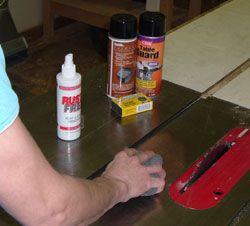
Question: I have an old table saw & jointer that I inherited from my father. His father bought them in the 1950s and they still work great. However, the tools have developed some rust on the table surfaces. It’s not deeply imbedded rust, but there’s a significant amount of it on the tops. I’m not sure what the tables are made of, but they are a dark steel color and are not soft at all, so I suspect they are steel. What is the best way to remove the rust from the surfaces without damaging the tops & is there something I can apply to the surfaces to prevent further rust in the future?
Answer: A magnet should tell you if the metal surface is aluminum or steel. But the real giveaway is the fact that the surface is rusting, which is a type of oxidation that needs the presence of iron (as well as oxygen and water) to occur. So your tops should be steel. More than likely they are cast iron given their age. On the metal surfaces not machined or dressed, the surface should have a granular look. Also, in areas like the webbed grate of the side tables on the table saw, you will see evidence indicating the top came from a mold.
Rust is removed by abrading it away. Sanding the metal top removes the rust and leaves scratches. You will need to sand with finer and finer sandpaper to remove the scratches from the previous grit. If you must, you can go higher and higher in grit until you get an almost mirror finish. This is only for looks, however. Most tops are not remotely close to a polished finish from the factory when new, so creating a mirror-like surface finish may cause more troubles (Oh, I’ve dinged/scraped my freshly polished top!) than it’s worth.
I would start with a somewhat fine grit so you don’t get overly aggressive and can see how quickly things move along. 320 or 400 grit wet-dry paper with some mineral spirits as a lubricating agent would be a good start. Very mild rust may come off with a nylon Scotchbrite pad. If the rust removal is slow going, step down a grit. Once you have all the rust off, you can stop there or step up to the next grit to remove the previous grit’s scratches. There are also rust removal products available such as Rust Free that work to remove surface rust and light to moderate scale from iron surfaces. Rust Free is acidic and should be used with care. Follow the label directions carefully.
Deep rust can cause pitting that you may not be able to remove with simple sanding. However, while perhaps unsightly, small pitting should not impede the function of the tool. With severe pitting, surface grinding at a machine shop would be necessary.
There are many aftermarket coating products you can apply to help fight rust formation. You can use simple paste floor wax that you spread out and then buff smooth when dry (like you would when waxing a car). Use floor wax only, never automotive wax or polish, as they contain silicone which can interfere with wood finishing. Other products such as Top-Cote spray on and form an invisible film to keep moisture at bay. Another product, Boeshield T-9, is for long-term rust prevention when storing your tools. It has a waxy emulsion that creates a barrier that lasts for months. The coating should be cleaned off before using the machine. To remove the film when it’s time to put your tools back into service, just spray on a fresh coat of Boeshield and then wipe off thoroughly.
You can also help prevent rust by using a desiccant such as a Silica Gel Canister. These canisters protect tools from rust by removing moisture from the air inside toolboxes and drawers. Zerust Anti-Corrosion Non-Slip Liners combine the Zerust ICT corrosion inhibiting formula with a heavy-duty non-slip PVC rubber mesh. The odorless, non-toxic Zerust formula and quality rubber mesh work together to protect your tools.
It’s always best to try to remove any surface rust the moment you notice its presence. Sandflex Rust Erasers work well to remove light rusting or spots of rust beginning to form on surfaces. The longer rust lingers on a metal surface, the deeper it penetrates and the more elbow grease you’ll need to use to get rid of it. Remember, rust never sleeps!

